MEDDEV 2[1].12-1 rev 6 附录 中英文
- 格式:doc
- 大小:157.00 KB
- 文档页数:11
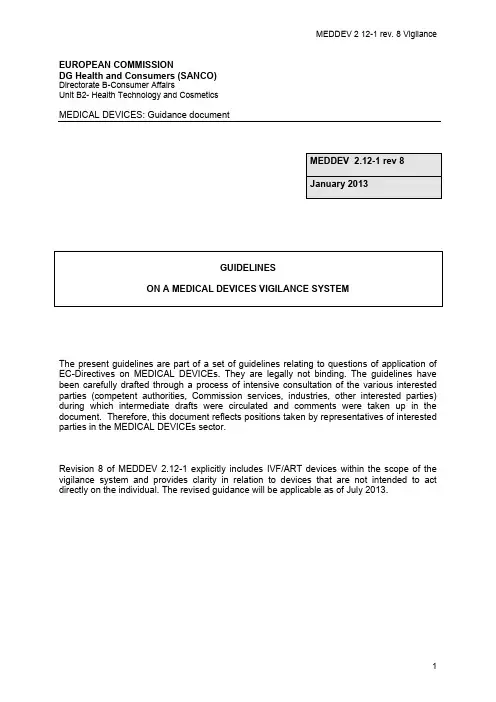
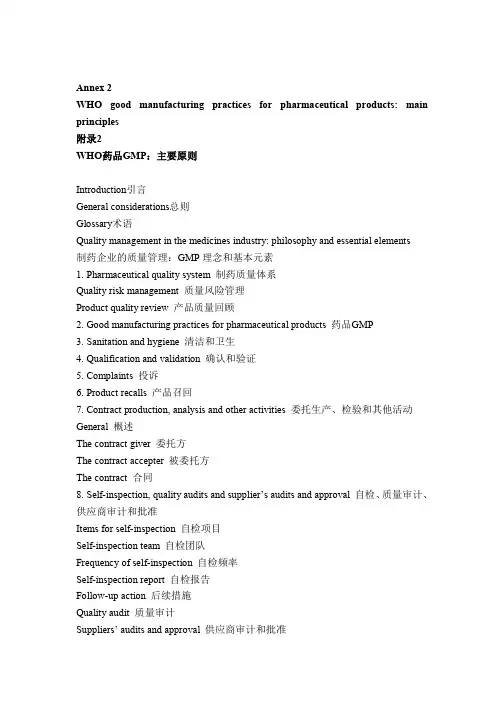
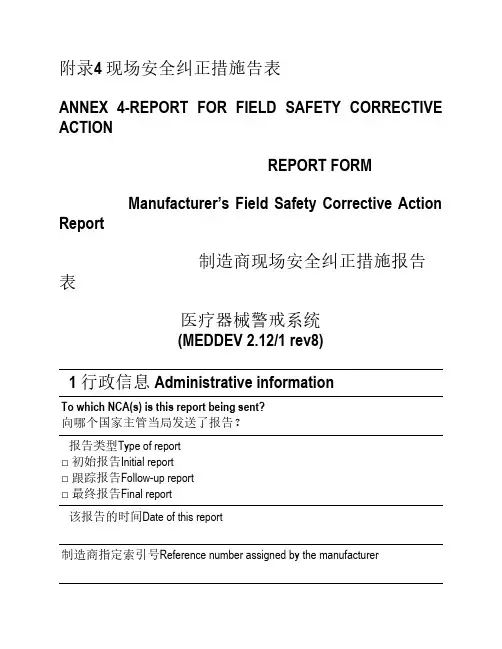
附录4 现场安全纠正措施告表ANNEX 4-REPORT FOR FIELD SAFETY CORRECTIVE ACTIONREPORT FORMManufacturer’s Field Safety Corrective Action Report制造商现场安全纠正措施报告表医疗器械警戒系统(MEDDEV 2.12/1 rev8)1 行政信息 Administrative informationTo which NCA(s) is this report being sent?向哪个国家主管当局发送了报告?报告类型Type of report□ 初始报告Initial report□ 跟踪报告Follow-up report□ 最终报告Final report该报告的时间Date of this report制造商指定索引号Reference number assigned by the manufacturer事故索引号及协作国家主管当局名称(适用时)Incident reference number and name of the co-ordinating NCA Competent Authority (if applicable)确定该报告的其它发送国家主管当局Identify to what other Competent Authorities this report was also sent2 报告提交人信息Information on submitter of the report发送人身份Status of submitter□ 制造商Manufacturer□ EEA内授权代表 Authorised Representative within EEA□ 其他(请表明其身份)Others: (identify the role)3 制造商信息 Manufacturer information制造商名称Manufacturer name制造商联系人Manufacturer’s contact person地址Address邮政编码 Postal code城市City电话Phone传真Fax电子邮件E-mail国家Country4 授权代表信息 Authorized Representative information 授权代表名称Name of the Authorized Representative授权代表联系人The Authorized Representative’s contact person地址Address邮政编码 Postal code城市City电话Phone传真Fax电子邮件E-mail国家Country5 国家联络点信息 National contact point information国家联络点名称 National contact point name联系人姓名Name of the contact person地址Address邮政编码 Postal code城市City电话Phone传真Fax电子邮件E-mail国家Country6 医疗器械信息 Medical device information分类Class□ 有源植入类AIMD Active implants□ MDD法规规定第Ш类 MDD Class Ш □IVD 附件Ⅱ列表A IVD AnnexⅡ List A□ MDD法规规定第Ⅱ类MDD Class Ⅱb □IVD 附件Ⅱ列表B IVD AnnexⅡ List B□ MDD分类Ⅱa MDD Class Ⅱa □IVD自测诊断器械IVD Devices for self-testing□ MDD分类 MDD ClassⅠ □ IVD一般 IVD General分类系统(最好是GMDN) Nomenclature system (preferable GMDN)分类系统代号Nomenclature code分类内容Nomenclature text商品名/品牌名/制造者Commercial name/brand name/make型号 Mode number 目录号catalogue number序列号/批号Serial number(s) or lot/batch number(s)软件版本号(适用时) Software version number (if applicable)制造日期/失效期Device Manufacturing date/Expiry date附件/随附器械(适用时) Accessories/associated device (if applicable)公告机构识别号码 Notified Body (NB) ID-number7 市场安全纠正措施描述Description of FSCA市场安全纠正措施背景信息和原因Background information and reason for the FSCA描述措施及其理由(纠正/预防)Description and justification of the action (corrective/preventive)分销商和使用者对所采取措施的建议Advice on actions to be taken by the distributor and the user.附加资料Attached please find□ 英文版市场安全公告Field Safety Notice (FSN) in English□ 国语版市场安全公告FSN in national language□ 其它(请详述)Others (please specify) …现场安全通报状态FSN Status□草稿 Draft□ 最终Final执行不同行动的时间表Time schedule for the implementation of the different actions在EEA和瑞士内受市场安全纠正措施影响的国家:These countries within the EEA and Switzerland are affected by this FSCA:- 在EEA,瑞士和土耳其内 - within the EEA, Switzerland and Turkey□AT □BE □BG □CH □CY □CZ □DE □DK □EE □ES □FI □FR □□GR □HU □IE □IS□IT □LI □LT □LU □LV □MT □NL □NO □PL □PT □RO □SE □□SK □TR-候补国家-Candidate Countries□HR□ALL EEA-,Candidate Countries and Switzerland-其他:-others:8 备注Comments本人保证就本人所掌握的知识范围,上述信息是正确的。
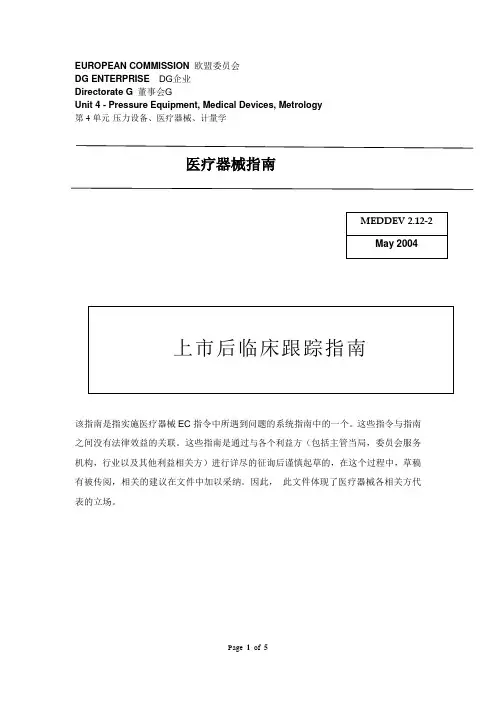
EUROPEAN COMMISSION 欧盟委员会DG ENTERPRISE DG企业Directorate G 董事会GUnit 4 - Pressure Equipment, Medical Devices, Metrology第4单元-压力设备、医疗器械、计量学医疗器械指南该指南是指实施医疗器械EC指令中所遇到问题的系统指南中的一个。
这些指令与指南之间没有法律效益的关联。
这些指南是通过与各个利益方(包括主管当局,委员会服务机构,行业以及其他利益相关方)进行详尽的征询后谨慎起草的,在这个过程中,草稿有被传阅,相关的建议在文件中加以采纳。
因此,此文件体现了医疗器械各相关方代表的立场。
CEC 临床评估小组5月18日, 2004年医疗器械指令之上市后临床跟踪前言:PMCF的基本原因和目标本文件的目的是指为制造商和通告机构就如何执行PMCF, 和履行上市后监督义务提供指导性意见。
参照医疗器械指令附录II 3. 1, 附录IV 3. 附录V 3, 附录VI 3.1 附录VII 4 (增加参阅AIMDD)。
虽然临床证据是上市前符合性评定程序的基本要素,但重要的是要认识到,这些上市前临床调查存在局限性。
虽然在上市前阶段已经收集了广泛的数据,但是并不能保证制造商能够察觉到不常见的并发症或问题,而这些问题只有在医疗器械被大范围的使用和长期运行后才会显现。
作为医疗器械制造商的质量体系,或上市后监督体系的一个部分,关键就是需识别和调查销售后的医疗器械在使用过程中所具有的风险。
制造商应建立上市后监督系统,并且对每一个产品或产品类都应有明确的PMS(上市后监督)策划。
因此,选择PMCF(上市后临床跟踪)看起来是实现此目的的一个方法。
通过建立一个长期的安全跟踪评审程序和侦查一些可能出现的风险,它可以使病人获得新的疗法,而这些风险仅仅依赖上市前的临床调查(仅仅要求相对很短的时间跟踪)和根据产品经验或产品警惕性都是不能完全充分地察觉到的。
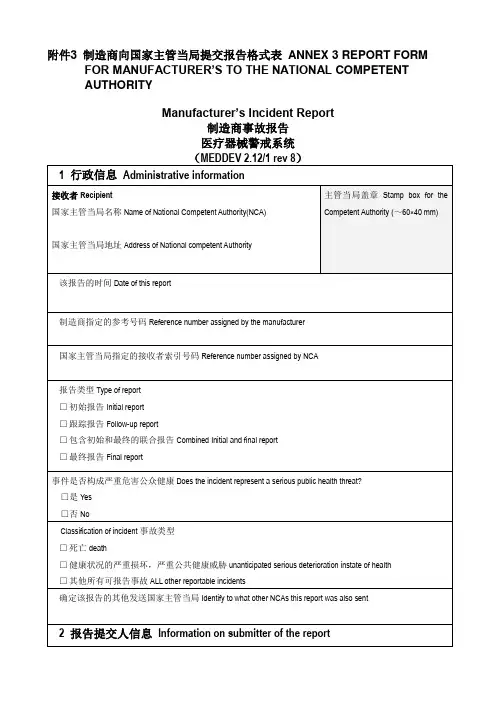
附件3 制造商向国家主管当局提交报告格式表ANNEX 3 REPORT FORM FOR MANUFACTURER’S TO THE NATIONAL COMPETENTAUTHORITYManufacturer’s Incident Report制造商事故报告医疗器械警戒系统本人保证就本人所掌握的知识范围,上述信息是正确的。
I affirm that the information given above is correct to the best of my knowledge.签名Signature姓名Name:城市City:日期Date:Submission of this report does not, in itself, represent a conclusion by the manufacturer and/or authorized representative or the National Competent Authority that the content of this report is complete or accurate, that the medical device(S) caused or contributed to the alleged death or deterioration the state of the health of any person.本报告的提交本身并不代表制造商和/或其授权代表或国家主管当局对本报告的内容完整或准确的结论,也不代表所列医疗器械的任何错误和/或医疗器械引起或促成了宣称的任何人的死亡或其健康六况的严重损坏。
附录4 欧洲市场安全纠正措施ANNEX 4 EUROPEAN FIELD SAFETY CORRECTIVE ACTION REPORT FORM医疗器械警戒系统(MEDDEV 2.12/1 rev 8)本人保证就本人所掌握的知识范围,上述信息是正确的。

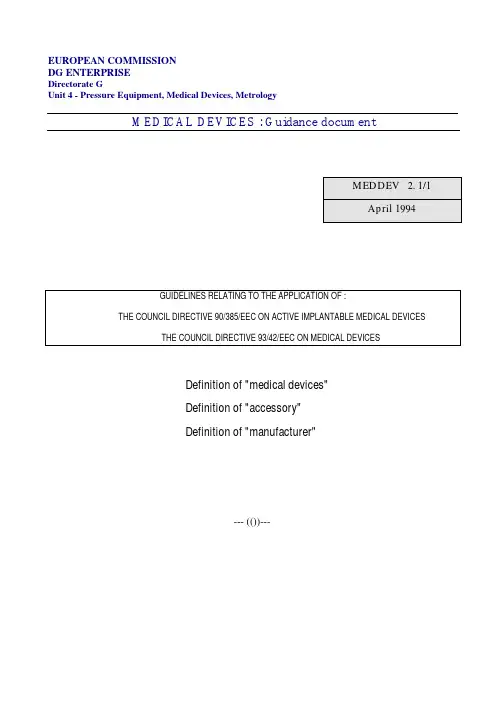
EUROPEAN COMMISSIONDG ENTERPRISEDirectorate GUnit 4 - Pressure Equipment, Medical Devices, MetrologyMEDICAL DEVICES : Guidance documentMEDDEV 2. 1/1April 1994GUIDELINES RELATING TO THE APPLICATION OF :THE COUNCIL DIRECTIVE 90/385/EEC ON ACTIVE IMPLANTABLE MEDICAL DEVICESTHE COUNCIL DIRECTIVE 93/42/EEC ON MEDICAL DEVICESDefinition of "medical devices"Definition of "accessory"Definition of "manufacturer"--- (())---LIST OF CONTENTSI.FIELD OF APPLICATION - DEFINITIONS1.Directive 93/42/EE on medical devices2.Directive 90/385/EEC on active implantable medical devices13.Interface with other directives- medical devices/medicinal products- medical devices/electromagnetic compatibility2- medical devices/personal protective equipment2II.CLASSIFICATION OF MEDICAL DEVICES COVERED BY DIRECTIVE 93/42/EEC3III.CONFORMITY ASSESSMENT PROCEDURES(*):1.CE-marking2.Application-Annex 5-Annex 2. Quality systems. Examination of the design dossier- Annex 33.Conduct of audits44.Format of decisions, design examination certificate5.Technical DossierIV.CUSTOM MADE DEVICES(*):V.DEVICES INTENDED FOR CLINICAL INVESTIGATIONS(*):VI.MEDICAL DEVICE VIGILANCE(*):E OF LANGUAGES(*):VIII.TRANSITIONAL PERIOD(*):1see MEDDEV. 5/93 rev. 22see MEDDEV 13/933see MEDDEV.10/93 rev. 14see MEDDEV. 1/94I.FIELD OF APPLICATION - DEFINITIONS1.Directive 93/42/EEC on medical devices1.1Definition of "medical devices"a)devices - accessoryThe definition of the term "medical device" together with thedefinition of "accessory" is determinant for the delimitation of the fieldof application of Directive 93/42/EEC. A slight difference existsbetween the definition in article 1(2) (a) of Directive 93/42/EEC and inarticle 1(2) of Directive 90/385/EEC.Following the latter directive, accessories are by definition medicaldevices, whilst following Directive 93/42/EEC, a distinction is madebetween "devices" and "accessories". Therefore within the meaning ofDirective 93/42/EEC, accessories are products in their own right and,although being treated as devices (article 1(1)) do not follow, as ageneral rule, the classification of related devices in conjunction withwhich they are used.Accessories are therefore following Directive 93/42/EEC to beclassified in their own right.b)medical purposeMedical devices are defined as articles which are intended to be usedfor a medical purpose. The medical purpose is assigned to a productby the manufacturer. The manufacturer determines through the label,the instruction for use and the promotional material related to a givendevice its specific medical purpose. As the directive aims essentially atthe protection of patients and users, the medical purpose relates ingeneral to finished products regardless of whether they are intendedto be used alone or in combination. This means that the protectionensured by the directive becomes valid for products having a stage ofmanufacture, where they are supplied to the final user.Following this concept, raw materials, components or intermediateproducts are as such normally not medical devices. Such rawmaterials may need to present properties or characteristics which aredeterminant for the safety and quality of finished devices. It istherefore the responsibility of the manufacturer of finished devices toselect and control by adequate means his raw materials orintermediate products (see Annex I, section 7.1; Annex II, section 3.2;Annex V, section 3.2 of Directive 93/42/EEC)Spare parts supplied for replacement of existing components of adevice, the conformity of which has already been established, are notmedical devices. If spare parts, however, change significantly thecharacteristics or performances of a device with regard to its alreadyestablished conformity, such spare parts are to be considered asdevices in their own right.c)customizingThe concept of "finished device" does not imply that a device whenreaching the final user is already in a state ready for use. Prior to usefurther preparatory processing, preparation, configuration,installation, assembling, adaptation or fitting to the needs of the useror patient may be required. Examples :-sterilisation of medical devices supplied non-sterile-assembling of systems-configuration of electronic equipment-preparation of a dental filling-fitting of contact lenses-adaptation of prosthesis to the needs of the patient.The aforementioned activities are normally not manufacturersactivities if they are carried out by the final user as part of the use orpreparation for use. In this context a distinction needs to be madebetween a typical professional activity performed by a healthcareprofessional and processing and assembling activities done by aspecialist for such processing. In the latter case relevant activities maybecome proper manufacturing or assembling activities relevant withinthe meaning of articles 11 and 12.A particular consideration in this context needs to be given for themanufacture of custom-made devices. Custom-made devices (such as dental appliances, prosthesis, hearing-aid inserts) are in most casesone-off devices and the Directive subjects their manufacture to theprocedure of article 11(6) in conjunction with Annex VIII. In thesecases intermediate products specifically intended for this kind ofcustom-made devices may be considered also as medical devices.This applies essentially to dental alloys, dental ceramics, modularcomponents for prosthesis, if the intended purpose of such products is specifically related to medical devices.d)medical - toiletry purposeThe definition of "medical device" should be understood to includeproducts intended to be used principally for a medical use. Thereforeproducts intended to have a toiletry or cosmetic purpose are notmedical devices even though they may be used for prevention of adisease. Examples for products for which a medical purpose cannormally not be established :-tooth brushes, dental sticks, dental floss;-baby diapers, hygiene tampons;-contact lenses without corrective function intended toprovide another colour to the eyes,-bleaching products for teeth [needs to be furtherdiscussed with regard to products intendedspecifically for application by dentists]-instruments for tattooing.Examples for products, where depending on the circumstances, amedical purpose can be established :-incontinence products.e)aids for handicapped personsIn the case of equipment intended for alleviation of or compensationfor a handicap, there must be a direct link between the correctivefunction and the person concerned. Therefore the followingequipment are not medical devices :-acoustic signals at traffic lights,-special water taps, toilet equipment for handicappedf)softwareThe following distinction can be made : software influencing theproper functioning of a device and software used in combination withnon-medical equipment.Software related to the functioning of a medical device may be part ofa device or a device in its own right if it is placed on the marketseparately from the related device.In the case of software intended for use with multipurpose informaticequipment a distinction has to be made between software providingfor a proper diagnostic or therapeutic tool and software for handlinggeneral patient-related data. Only in the first case may a medicalpurpose be determined. Examples for medical devices :-calculation of anatomical sites of the body,-image enhancing software intended for diagnosticpurpose.-software for programming a medical deviceThere is no medical purpose in the case of software used foradministration of general patient datag)multipurpose productsProducts with a multiple purpose which may be used occasionally in amedical environment are normally not medical devices, unless aspecific medical intended purpose is assigned to them. Examples :-multipurpose PC, printer, scanner, ..._magnetoscope, screen.1.2Definition of "accessory"The question whether a product is a "device" or a "accessory" has notpractical consequence. Following article 1(1) of Directive 93/42/EEC,"accessories shall be treated as medical devices in their own right". Therefore the main question is whether a product with a rather remote link to amedical use can still be considered as "accessory" (article 1(2)b) and as amatter of consequence is covered by the directive.The definition of "accessory" requires that the accessory is specificallyintended by the manufacturer of the accessory to be used together with adevice. The intended use of the accessory must be such as to enable a device to be used in accordance with its intended use. Therefore a product can only become an accessory to a medical device if the manufacturer of such aproduct establishes an intended use in conjunction with one or severalmedical devices.Examples for accessories depending on defined circumstances of device-related use :-sterilizers for use in a medical environment,-pouches for packaging re-sterilised medical devices,-specific battery chargers for battery driven electromedicaldevices,-contact lens care products, disinfectants specificallyintended for invasive medical devices-special water treatment device for use in conjunction withdialyzing machines,-gas cylinders/pressure release devices for use inconjunction with anaesthesia machines.1.3Definition of "manufacturer"Users in-house manufacturingThe Directive defines a manufacturer as the natural or legal personresponsible for defined manufacturing activities related to a device with aview to its being placed on the market under the manufacturers own name.The reason for this link with the placing on the market is that the directives aims to subject to its protection requirements the transaction of a device from the sphere of a manufacturer towards the public. The directive does notprovide any specific provisions for the case where a device is manufactured by the user (for example, a hospital) without being transferred to anotherperson. The decision to which extent such in-house manufacturing activities by hospitals are subjected to legal requirements, belongs therefore to thenational legislator. This relates however exclusively to such in-housemanufacturing activities where a device remains within the users, but not to cases where, for example, a hospital produces orthopaedic devices for usewith patients.。
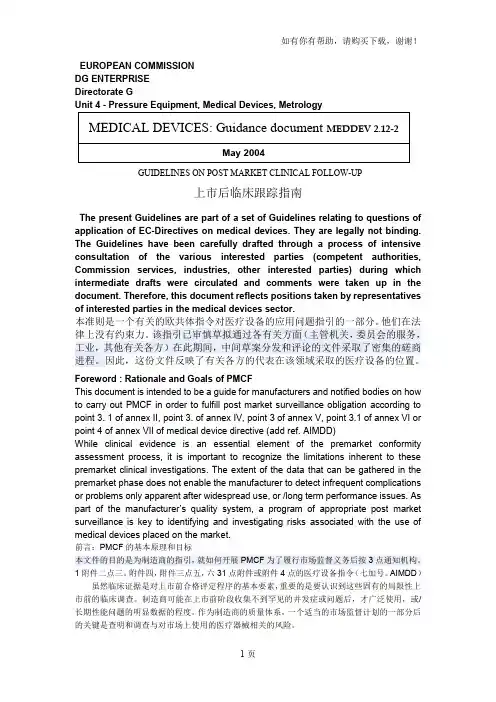
EUROPEAN COMMISSIONDG ENTERPRISEDirectorate GGUIDELINES ON POST MARKET CLINICAL FOLLOW-UP上市后临床跟踪指南The present Guidelines are part of a set of Guidelines relating to questions of application of EC-Directives on medical devices. They are legally not binding. The Guidelines have been carefully drafted through a process of intensive consultation of the various interested parties (competent authorities, Commission services, industries, other interested parties) during which intermediate drafts were circulated and comments were taken up in the document. Therefore, this document reflects positions taken by representatives of interested parties in the medical devices sector.本准则是一个有关的欧共体指令对医疗设备的应用问题指引的一部分。
他们在法律上没有约束力。
该指引已审慎草拟通过各有关方面(主管机关,委员会的服务,工业,其他有关各方)在此期间,中间草案分发和评论的文件采取了密集的磋商进程。
因此,这份文件反映了有关各方的代表在该领域采取的医疗设备的位置。
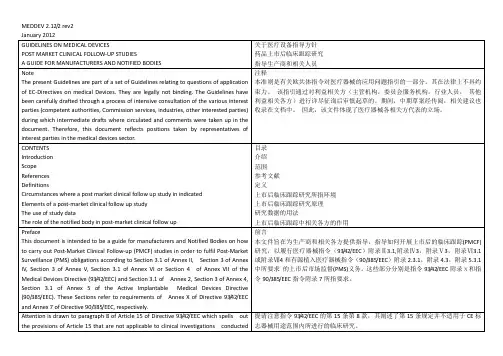
MEDDEV 2.12/2 rev2 January 2012GUIDELINES ON MEDICAL DEVICESPOST MARKET CLINICAL FOLLOW-UP STUDIESA GUIDE FOR MANUFACTURERS AND NOTIFIED BODIES 关于医疗设备指导方针药品上市后临床跟踪研究指导生产商和相关人员NoteThe present Guidelines are part of a set of Guidelines relating to questions of application of EC-Directives on medical Devices. They are legally not binding. The Guidelines have been carefully drafted through a process of intensive consultation of the various interest parties (competent authorities, Commission services, industries, other interested parties) during which intermediate drafts where circulated and comments were taken up in the document. Therefore, this document reflects positions taken by representatives of interest parties in the medical devices sector. 注释本准则是有关欧共体指令对医疗器械的应用问题指引的一部分。
其在法律上不具约束力。
该指引通过对利益相关方(主管机构,委员会服务机构,行业人员,其他利益相关各方)进行详尽征询后审慎起草的。
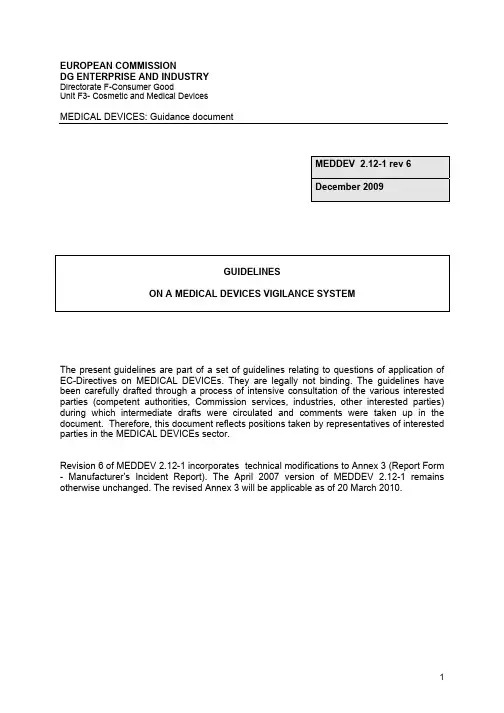
EUROPEAN COMMISSIONDG ENTERPRISE AND INDUSTRYDirectorate F-Consumer GoodUnit F3- Cosmetic and Medical DevicesMEDICAL DEVICES: Guidance documentMEDDEV 2.12-1 rev 6December 2009GUIDELINESON A MEDICAL DEVICES VIGILANCE SYSTEMThe present guidelines are part of a set of guidelines relating to questions of application of EC-Directives on MEDICAL DEVICEs. They are legally not binding. The guidelines have been carefully drafted through a process of intensive consultation of the various interested parties (competent authorities, Commission services, industries, other interested parties) during which intermediate drafts were circulated and comments were taken up in the document. Therefore, this document reflects positions taken by representatives of interested parties in the MEDICAL DEVICEs sector.Revision 6 of MEDDEV 2.12-1 incorporates technical modifications to Annex 3 (Report Form - Manufacturer's Incident Report). The April 2007 version of MEDDEV 2.12-1 remains otherwise unchanged. The revised Annex 3 will be applicable as of 20 March 2010.T ABLE OF C ONTENTST ABLE OF C ONTENTS (2)1FOREWORD (4)2INTRODUCTION (4)3SCOPE (5)3.1GENERAL PRINCIPLES (6)3.1.1FOR MANUFACTURERS (6)3.1.2FOR MANUFACTURERS OF IVDS (7)3.1.3FOR NATIONAL COMPETENT AUTHORITIES (7)3.1.4FOR USERS (8)4DEFINITIONS (8)4.1ABNORMAL USE (8)4.2AUTHORISED REPRESENTATIVE (8)4.3CORRECTIVE ACTION (8)4.4DRUG / DEVICE COMBINATION PRODUCT (9)4.5EUDAMED (9)4.6FIELD SAFETY CORRECTIVE ACTION (FSCA) (9)4.7FIELD SAFETY NOTICE (FSN) (10)4.8HARM (10)4.9IMMEDIATELY (10)4.10INCIDENT (10)4.11INDIRECT HARM (10)4.12INTENDED PURPOSE (11)4.13MANUFACTURER (11)4.14MEDICAL DEVICE (11)4.15OPERATOR (11)4.16PERIODIC SUMMARY REPORTING (11)4.17SERIOUS PUBLIC HEALTH THREAT (12)4.18TREND REPORTING (12)4.19UNANTICIPATED (12)4.20USE ERROR (12)4.21USER (12)5MANUFACTURERS´ ROLE (12)5.1INCIDENT REPORTING SYSTEM (13)5.1.1CRITERIA FOR INCIDENTs TO BE REPORTED BY MANUFACTURERS TOCOMPETENT AUTHORITIES (13)5.1.2 CONDITIONS FOR PERIODIC SUMMARY REPORTING UNDER THE MEDICALDEVICE VIGILANCE SYSTEM (15)5.1.2.1INCIDENTS DESCRIBED IN A FIELD SAFETY NOTICE (15)5.1.2.2COMMON AND WELL-DOCUMENTED INCIDENTS (15)5.1.3CONDITIONS WHERE REPORTING UNDER THE MEDICAL DEVICE VIGILANCESYSTEM IS NOT USUALLY REQUIRED (16)5.1.3.1DEFICIENCY OF A DEVICE FOUND BY THE USER PRIOR TO ITS USE (16)5.1.3.2EVENT CAUSED BY PATIENT CONDITIONS (16)5.1.3.3SERVICE LIFE OR SHELF-LIFE OF THE MEDICAL DEVICE EXCEEDED (17)5.1.3.4PROTECTION AGAINST A FAULT FUNCTIONED CORRECTLY (17)5.1.3.5 EXPECTED AND FORESEEABLE SIDE EFFECTS (18)5.1.3.6 NEGLIGIBLE LIKELIHOOD OF OCCURRENCE OF DEATH OR SERIOUSDETERIORATION IN STATE OF HEALTH (19)5.1.4TREND REPORTS (19)5.1.5REPORTING OF USE ERROR AND ABNORMAL USE (20)5.1.5.1REPORTABLE USE ERRORS (20)5.1.5.2USE ERROR WHERE REPORTING UNDER THE MEDICAL DEVICE VIGILANCESYSTEM IS NOT USUALLY REQUIRED (20)5.1.5.3CONSIDERATION FOR HANDLING ABNORMAL USE (20)5.1.6DETAILS TO BE INCLUDED IN MANUFACTURER REPORTS (21)5.1.7TIMESCALE FOR THE INITIAL REPORTING OF AN INCIDENT (21)5.1.8TO WHOM TO REPORT (21)5.2HANDLING OF USER REPORTS SUBMITTED TO THE MANUFACTURER BY ANATIONAL COMPETENT AUTHORITY (22)5.3INVESTIGATIONS (22)5.3.1 PRINCIPLES (22)5.3.2ACCESS TO THE DEVICE SUSPECTED TO BE INVOLVED IN THE INCIDENT (22)5.4 OUTCOME OF AN INVESTIGATION AND FOLLOW-UP (23)5.4.1 PRINCIPLES (23)5.4.2FOLLOW-UP REPORT (23)5.4.3FINAL REPORT (23)5.4.4 FIELD SAFETY CORRECTIVE ACTION (23)5.4.4.1NOTIFICATION TO NATIONAL COMPETENT AUTHORITIES (24)5.4.4.2CONTENT OF THE FIELD SAFETY NOTICE (25)6.RESPONSIBILITIES OF NATIONAL COMPETENT AUTHORITY (26)6.1ACTIONS ON A REPORT FROM USERS OR OTHER SYSTEMS (26)6.2RISK EVALUATION AND SUBSEQUENT ACTIONS (27)6.2.1RISK EVALUATION BY THE NATIONAL COMPETENT AUTHORITY (27)6.2.2MONITORING OF MANUFACTURERS SUBSEQUENT ACTIONS (27)6.2.3NATIONAL COMPETENT AUTHORITY ACTIONS (28)6.3CO-ORDINATION BETWEEN COMPETENT AUTHORITIES (28)6.3.1CIRCUMSTANCES WHERE A COORDINATING NATIONAL COMPETENTAUTHORITY IS NEEDED (28)6.3.2DETERMINATION OF THE COORDINATING NATIONAL COMPETENT AUTHORITY296.3.3THE TASKS OF THE CO-ORDINATING NATIONAL COMPETENT AUTHORITY (29)6.3.4SAFEGUARD CLAUSE (30)6.3.5DISSEMINATION OF INFORMATION BETWEEN National COMPETENTAUTHORITIES (30)6.3.6DISSEMINATION OF INFORMATION OUTSIDE NATIONAL COMPETENTAUTHORITIES BY A NATIONAL COMPETENT AUTHORITY (31)6.4COMPLETION OF THE INVESTIGATION (31)7THE ROLE OF THE NOTIFIED BODIES (32)8THE ROLE OF THE COMMISSION (32)9USERS ROLE WITHIN THE VIGILANCE SYSTEM (32)10.1ANNEX 1 EXAMPLES OF INCIDENTs WHICH THE MANUFACTURER SHOULDREPORT (34)10.2ANNEX 2 EXTRACTS FROM DIRECTIVES RELATING TO "MEDICAL DEVICESVIGILANCE" (36)10.3ANNEX 3 REPORT FORM FOR MANUFACTURER’S TO THE NATIONAL COMPETENTAUTHORITY (39)10.4ANNEX 4 EUROPEAN FIELD SAFETY CORRECTIVE ACTION REPORT FORM (44)10.5ANNEX 5 TEMPLATE FOR A FIELD SAFETY NOTICE (48)10.6ANNEX 6 SUGGESTED NATIONAL COMPETENT AUTHORITY REPORT FORMAT (50)10.7ANNEX 7 TITLES OF GLOBAL HARMONISATION TASK FORCE STUDY GROUP 2DOCUMENTS USED IN THE DEVELOPMENT OF THIS MEDDEV AND/OR CITED (53)10.8ANNEX 8 LIST OF THE USED ABBREVIATIONS (54)10.9ANNEX 9 GUIDANCE TO MANUFACTURERS WHEN INVOLVING USERS IN THEVIGILANCE SYSTEM (55)1 FOREWORDThese guidelines on the Medical Device Vigilance System are part of a set of Medical Device Guidelines that promote a common approach by MANUFACTURERs and Notified Bodies involved in the conformity assessment procedures according to the relevant annexes of the directives, and by the National Competent Authorities charged with safeguarding public health.They have been carefully drafted through a process of consultation with various interested parties during which intermediate drafts were circulated and comments were taken up in the documents. Therefore, it reflects positions taken in particular by representatives of National Competent Authorities and Commission Services, Notified Bodies, industry and other interested parties in the MEDICAL DEVICEs sector.The guidelines are regularly updated accordingly with regulatory developments. The latest version of the guidelines should always be used. This revision of these guidelines has: •carefully considered and transposed into the European context the Global Harmonisation Task Force (GHTF)1 international regulatory guidance documents on vigilance and post market surveillance;•addressed the introduction of European medical device database EUDAMED; •amended the document in light of experience with previous clauses.These guidelines are not legally binding. It is recognised that under given circumstances, for example, as a result of scientific developments, an alternative approach may be possible or appropriate to comply with the legal requirements.Nevertheless, due to the participation of the aforementioned interested parties and of experts from National Competent Authorities, it is anticipated that the guidelines will be followed within the Member States and, therefore, work towards uniform application of relevant directive provisions and common practices within Member States.However, only the text of the Directives is authentic in law. On certain issues not addressed in the Directives, national legislation may be different from these guidelines.2 INTRODUCTIONThese guidelines describe the European system for the notification and evaluation of INCIDENTs and FIELD SAFETY CORRECTIVE ACTIONS (FSCA) involving MEDICAL DEVICEs, known as the Medical Device Vigilance System.The principal purpose of the Medical Device Vigilance System is to improve the protection of health and safety of patients, USERs and others by reducing the likelihood of reoccurrence of the INCIDENT elsewhere. This is to be achieved by the evaluation of reported INCIDENTs and, where appropriate, dissemination of information, which could be used to prevent such repetitions, or to alleviate the consequences of such INCIDENTs.These guidelines are intended to facilitate the uniform application and implementation of the Medical Device Vigilance System requirements contained within:1 A list of the used abbreviations is listed in annex 8•the Directive for Active Implantable Medical Devices (AIMD), 90/385/EEC•the Directive for Medical Devices (MDD), 93/42/EEC•the In Vitro Diagnostic Medical Devices Directive (IVDD), 98/79/EC.FIELD SAFETY CORRECTIVE ACTION (FSCA), FIELD SAFETY NOTICE (FSN), USE ERROR and ABNORMAL USE are new concepts introduced in this revision of the guideline to enhance and clarify the European Medical Device Vigilance System while promoting harmonisation with GHTF provisions.The Medical Device Vigilance System is intended to facilitate a direct, early and harmonised implementation of FIELD SAFETY CORRECTIVE ACTION across the Member States where the device is in use, in contrast to action taken on a country by country basis.Corrective action includes, but may not be confined to: a device recall; the issue of a FIELD SAFETY NOTICE; additional surveillance/modification of devices in use; modification to future device design, components or manufacturing process; modification to labelling or instructions for use.3 SCOPEThese guidelines describe the requirements of the Medical Device Vigilance System as it applies to or involves:• MANUFACTURERs2•National Competent Authorities (NCA)•the European Commission•Notified Bodies•USERs and others concerned with the continuing safety of MEDICAL DEVICEsThese guidelines cover the actions to be taken once the MANUFACTURER or National Competent Authority receives information concerning an INCIDENT involving a MEDICAL DEVICE. Information on INCIDENTs which should be reported under the Medical Device Vigilance System may come to the attention of MANUFACTURERs via the systematic procedure to review experience gained from devices in the post-production phase, or by other means (see annexes II, IV, V, VI, VII of MDD and annexes III, IV, VI and VII of IVDD). The term "post-marketing surveillance" as referred to in Annexes 2, 4, 5 in AIMD has the same meaning as the aforementioned "systematic procedure".These guidelines cover Article 8 (AIMD), Article 10 (MDD) and Article 11 (IVDD) outlining the obligations of Member States upon the receipt of INCIDENT reports, from MANUFACTURERs or other sources, concerning any MEDICAL DEVICE. They also include guidance to National Competent Authorities about the issue and receipt of information from National Competent Authorities outside Europe who are involved in the GHTF National Competent Authority Report (NCAR) exchange programme.These guidelines are relevant to INCIDENTs occurring within the Member States of the European Economic Area (EEA) and Switzerland with regard to:•a) devices which carry the CE-mark2 including their Authorised Representatives and persons responsible for placing on the market, see section 4 on definitions.•b) devices that do not carry the CE-mark but fall under the directives scope (e.g. custom made devices)•c) devices that do not carry the CE mark because they were placed on the market before the entry into force of the medical devices directives.•d) devices that do not carry the CE-mark but where such INCIDENTs lead to CORRECTIVE ACTION(s) relevant to the devices mentioned in a), b) and c).These guidelines cover FIELD SAFETY CORRECTIVE ACTION relevant to CE-marked devices which are offered for sale or are in use within the EEA and Switzerland.These guidelines make no recommendations on the structure of the systems by which MANUFACTURERs gather information concerning the use of devices in the post-production phase, of which the Medical Device Vigilance System is an integral part. Such recommendations are outside the scope of this document.3.1 GENERAL PRINCIPLES3.1.1 FOR MANUFACTURERS•The MANUFACTURER or his AUTHORISED REPRESENTATIVE shall notify the relevant National Competent Authority about INCIDENTs and FIELD SAFETY CORRECTIVE ACTIONs when the reporting criteria are met (see section 5.1 and 5.4). •The MANUFACTURER has the responsibility for investigating INCIDENTs and for taking any CORRECTIVE ACTION necessary (see section 5.2 and 5.3).•The MANUFACTURER should ensure that these guidelines are made known to their AUTHORISED REPRESENTATIVEs within the EEA and Switzerland, persons responsible for placing devices on the market and any other agents authorised to act on their behalf for purposes related to medical devices vigilance, so that the MANUFACTURERs' responsibilities may be fulfilled.•The MANUFACTURER should ensure that their AUTHORISED REPRESENTATIVE within the EEA and Switzerland, persons responsible for placing devices on the market and any other agents authorised to act on their behalf for purposes relating to medical devices vigilance, are kept informed of INCIDENT reports as appropriate.•Where an INCIDENT occurs as a consequence of the combined use of two or more separate devices (and/or accessories) made by different MANUFACTURERs, each MANUFACTURER should submit a report to the relevant National Competent Authority (see section 5.1)•MANUFACTURERs must keep the Notified Body advised of issues occurring in the post production phase affecting the certification (see the relevant annexes of the relevant directives and section 7 of this document). This would include relevant changes derived from the vigilance system.The act of reporting an INCIDENT to a National Competent Authority is not to be construed as an admission of liability for the INCIDENT and its consequences. Written reports may carry a disclaimer to this effect.When placing on the market of a particular model of MEDICAL DEVICE ceases, the MANUFACTURER’s vigilance reporting obligations under the Medical Device Directives remain. However, a MANUFACTURERs legal trading arrangements change with mergers and acquisitions etc. Where the vigilance and other post market surveillance obligations are being transferred to another legal entity it is important that post market surveillance activitiescontinue and that Competent Authorities are appraised of the implications and provided with new contact details as soon as possible, so that any detrimental effects on the functioning of the vigilance system are minimised.For a complete description of the MANUFACTURER’s role in the Medical Device Vigilance System, see section 5 of these guidelines.3.1.2 FOR MANUFACTURERS OF IVDSVigilance reporting for IVDs may be more difficult since IVDs do not generally come into contact with patients. Therefore, it can be difficult to demonstrate direct HARM to patients, unless the device itself causes deterioration in state of health. HARM to patients is more likely to be indirect - a result of action taken or not taken on the basis of an incorrect result obtained with an IVD. Whether as a result of direct or INDIRECT HARM, INCIDENTs should be reported.It may be difficult to determine if a serious deterioration in the state of a patient’s health was or could be the consequence of an erroneous result obtained with an IVD, or if the HARM was the consequence of an error by the USER or third party. There should be a predisposition to report under such circumstances (see section 5.1).In the case of potential errors by USERs or third parties, labelling and instructions for use should be carefully reviewed for any possible inadequacy. This is particularly true for devices used for self-testing where a medical decision may be made by the patient. Inadequacies in the information supplied by the MANUFACTURER that led or could have led to HARM to USERs, patients or third parties should be reported.In particular, it can be extremely difficult to judge events in which no HARM was caused, but where HARM could result if the event was to occur again elsewhere.3.1.3 FOR NATIONAL COMPETENT AUTHORITIESFor the purposes of Medical Devices Vigilance System, Member States are represented by appointed National Competent Authorities, their vigilance contact points being listed on the European Commission web site:http://ec.europa.eu/enterprise/medical_devices/contact_links_en.htm•The National Competent Authority monitors the investigation of the INCIDENT carried out by the MANUFACTURER.•The National Competent Authority should take any further action that may be necessary to supplement the actions of the MANUFACTURER.•Depending on the outcome to the investigation, any information necessary for the prevention of further INCIDENTs (or the limitation of their consequences) should be disseminated by the National Competent Authority.•Member States should ensure that organisations and individuals involved in purchasing MEDICAL DEVICEs and in the provision of health-care are aware that their co-operation is vital in providing the first link in the vigilance chain. In order to enhance the efficiency of the Medical Device Vigilance System, National Competent Authorities should encourage the reporting of INCIDENTs by the USER and other professionals involved in the distribution, the delivery or putting in to service of the device. This includes organisations and individuals responsible for providing calibration and maintenance for MEDICAL DEVICEs. Such reports may be made directly to the MANUFACTURER or to the National Competent Authority as well depending on national practice.Information held by National Competent Authorities in connection with the Medical Device Vigilance System is to be held in confidence, as defined by the relevant articles of the directives3. However, any INCIDENT report should be available on request, and in confidence, to the other European Competent Authorities and to other National Competent Authorities participating in the GHTF exchange programme.For a complete description of the National Competent Authority’s role in the Medical Device Vigilance System, see section 6 of this guideline.USERS3.1.4 FOR•USERs should report INCIDENTs with MEDICAL DEVICEs to the MANUFACTURER or to the National Competent Authority depending on national practice.•Once corrective (or other) action is identified, hospital administrators, medical practitioners and other health-care professionals, and USER representatives responsible for the maintenance and the safety of MEDICAL DEVICEs, can take the necessary steps.Such steps should, where practicable, be taken in co-operation with the MANUFACTURER.For a complete description of the USER’s role in the Medical Device Vigilance System, see section 9 of this guideline.4 DEFINITIONS4.1 ABNORMAL USEAct or omission of an act by the OPERATOR or USER of a MEDICAL DEVICE as a result of conduct which is beyond any means of risk control by the MANUFACTURER.Reference: EN IEC 60601-1-64.2 AUTHORISED REPRESENTATIVEAny natural or legal person established in the Community who, explicitly designated by the MANUFACTURER, acts and may be addressed by authorities and bodies in the Community instead of the MANUFACTURER with regard to the latter’s obligations under the directive.4.3 CORRECTIVE ACTIONAction to eliminate the cause of a potential nonconformity or other undesirable situation. NOTE1: There can be more than one cause for non-conformity.NOTE 2: Corrective action is taken to prevent recurrence whereas preventive action is taken to prevent occurrence.Reference: EN ISO 9000:2000, 3.6.53 AIMD 15, MDD 20 and IVDD 204.4 DRUG / DEVICE COMBINATION PRODUCTA MEDICAL DEVICE incorporating a medicinal product or substance where the action of the medicinal product or substance is ancillary to that of the device. In this case, the lead directive are the Medical Devices Directives (AIMD, MDD).4.5 EUDAMEDThe European database for MEDICAL DEVICEs EUDAMED is to centralise:•data relating to registration of MANUFACTURERS and MEDICAL DEVICES placed on the Community market,•data relating to certificates issued, modified, supplemented, suspended,,withdrawn or refused,•data obtained in accordance with the vigilance procedure.Reference: Article 14a of MDD and article 10 of IVDD.4.6 FIELD SAFETY CORRECTIVE ACTION (FSCA)A FIELD SAFETY CORRECTIVE ACTION is an action taken by a MANUFACTURER to reduce a risk of death or serious deterioration in the state of health associated with the use of a MEDICAL DEVICE that is already placed on the market. Such actions should be notified via a FIELD SAFETY NOTICE.NOTE 1:The FSCA may include- the return of a MEDICAL DEVICE to the supplier;- device modification;- device exchange;- device destruction;- retrofit by purchaser of MANUFACTURER's modification or design change;- advice given by MANUFACTURER regarding the use of the device (e.g. where the device is no longer on the market or has been withdrawn but could still possibly be in usee.g. implants or change in analytical sensitivity or specificity for diagnostic devices)A device modification can include:- permanent or temporary changes to the labelling or instructions for use;- software upgrades including those carried out by remote access;- modification to the clinical management of patients to address a risk of death or serious deterioration in state of health related specifically to the characteristics of the device. For example:- For implantable devices it is often clinically unjustifiable to explant the device.Corrective action taking the form of special patient follow-up, irrespective ofwhether any affected un-implanted devices remain available for return, constitutesFSCA.- For any diagnostic device (e.g. IVD, imaging equipment or devices) the recall of patients for retesting or the retest or review of previous results constitutes FSCA.- advice relating to a change in the way the device is used e.g. IVD MANUFACTURER advises revised quality control procedure -use of third party controls or more frequent calibration or modification of control values for IVDs.NOTE 2: This guideline uses the definition of FSCA as synonym for recall mentioned in article 10(1), paragraph 1b) of the MDD and Article 11 IVD Directive since there is no harmonised definition of recall.4.7 FIELD SAFETY NOTICE (FSN)A communication to customers and/or USERs sent out by a MANUFACTURER or its representative in relation to a Field Safety Corrective Action.4.8 HARMPhysical injury or damage to the health of people, or damage to property or the environment. Reference: ISO/IEC Guide 51:19994.9 IMMEDIATELYFor purposes of this guideline, IMMEDIATELY means without any delay that could not be justified.4.10 INCIDENT“Any malfunction or deterioration in the characteristics and/or performance of a device, as well as any inadequacy in the labeling or the instructions for use which, directly or indirectly, might lead to or might have led to the death of a patient, or USER or of other persons or to a serious deterioration in their state of health.”Reference: Article 10 of the MDDNote 1: There is a similar definition in Article 8 of the AIMD and Article 11 IVD Directive with minor wording differences.Note 2: A description of “serious deterioration in the state of health” is given in section 5.1.1.(C) of this document.4.11 INDIRECT HARMSome diagnostic devices and all IVDs do not act directly on the individual. HARM may occur as a consequence of the medical decision, action taken/not taken on the basis of information or result(s) provided by the device.Examples include• misdiagnosis,•delayed diagnosis,• delayed treatment,• inappropriate treatment,•transfusion of inappropriate materials.For self-testing devices, a medical decision may be made by the USER of the device who is also the patient.4.12 INTENDED PURPOSEThe use for which the device is intended according to the data supplied by the MANUFACTURER on the labelling, in the instructions and/or in promotional materials. Reference: Article 1.2 (h) of the IVDD and Article 1.2 (g) of the MDD4.13 MANUFACTURERThe natural or legal person with responsibility for the design, manufacture, packaging and labelling of a device before it is placed on the market under his own name, regardless of whether these operations are carried out by that person himself or on his behalf by a third party.Reference: Article 1.2 (f) of the IVDD and Article 1.2 (f) of the MDD4.14 MEDICAL DEVICEFor the purpose of the Medical Devices Directives 90/385/EEC, 93/42/EEC and 98/79/EEC, any instrument, apparatus, appliance, material or other Article, whether used alone or in combination, including the software necessary for its proper application intended by the MANUFACTURER to be used for human beings for the purpose of:- diagnosis, prevention, monitoring, treatment or alleviation of disease,- diagnosis, monitoring, treatment, alleviation of or compensation for an injury or handicap,- investigation, replacement or modification of the anatomy or of aprocess,physiological-control of conception,and which does not achieve its principal intended action in or on the human body by pharmacological, immunological or metabolic means, but which may be assisted in its function by such means.4.15 OPERATORPerson handling equipment.4.16 PERIODIC SUMMARY REPORTINGPERIODIC SUMMARY REPORTING is an alternative reporting regime that is agreed between the MANUFACTURER and the National Competent Authority for reporting similarINCIDENTs with the same device or device type in a consolidated way where the root cause is known or an FSCA has been implemented.4.17 SERIOUS PUBLIC HEALTH THREATAny event type which results in imminent risk of death, serious deterioration in state of health, or serious illness that requires prompt remedial action.This would include:•events that are of significant and unexpected nature such that they become alarming as a potential public health hazard, e.g. human immunodeficiency virus (HIV) or Creutzfeldt-Jacob Disease (CJD). These concerns may be identified by either the National Competent Authority or the MANUFACTURER.•the possibility of multiple deaths occurring at short intervals.Reference: GHTF SG2 N33R114.18 TREND REPORTINGA reporting type used by the MANUFACTURER when a significant increase in events not normally considered to be INCIDENTs according to section 5.1.3. occurred and for which pre-defined trigger levels are used to determine the threshold for reporting.NOTE: GHTF SG2 document N36 'MANUFACTURER's TREND REPORTING of Adverse INCIDENTs' provides useful guidance (see annex 7).'4.19 UNANTICIPATEDA deterioration in state of health is considered UNANTICIPATED if the condition leading tothe event was not considered in a risk analysis.NOTE: Documented evidence in the design file is needed that such analysis was used to reduce the risk to an acceptable level, or that this risk is well known by the intended USER. 4.20 USE ERRORAct or omission of an act, that has a different result to that intended by the MANUFACTURER or expected by the OPERATOR of the MEDICAL DEVICE.4.21 USERThe health care institution, professional, carer or patient using or maintaining MEDICAL DEVICES.5 MANUFACTURERS´ ROLE5.1 INCIDENT REPORTING SYSTEMThe MANUFACTURER or their AUTHORISED REPRESENTATIVE must submit an initial INCIDENT report to the National Competent Authority for recording and evaluation. Each initial report must lead to a final report unless the initial and the final report are combined into one report. But not every INCIDENT report will lead to a corrective action.As a general principle, there should be a pre-disposition to report rather than not to report in case of doubt on the reportability of an INCIDENT.Reference to the following considerations may be made in the report, or should be kept on file by the MANUFACTURER in the case of a decision not to report.INCIDENTs which occurred outside the EEA and Switzerland and do not lead to a FIELD SAFETY CORRECTIVE ACTION relevant to these geographic areas do not need to be reported. Incidents which occurred outside the EEA and Switzerland and led to a FIELD SAFETY CORRECTIVE ACTION relevant to the above-mentioned geographical areas must be reported as a FIELD SAFETY CORRECTIVE ACTION.Where appropriate, MANUFACTURERs should notify their AUTHORISED REPRESENTATIVE, persons responsible for placing devices on the market and any other agents (e.g. distributors) authorised to act on their behalf of INCIDENTs and FSCA reported under the Medical Device Vigilance System.If the MANUFACTURER is located outside the EEA and Switzerland, a suitable contact point within should be provided. This may be the MANUFACTURER's AUTHORISED REPRESENTATIVE, persons responsible for placing devices on the market or any other agent authorised to act on their behalf for purposes relating to Medical Devices Vigilance.Any report should not be unduly delayed because of incomplete information.5.1.1 CRITERIA FOR INCIDENTs TO BE REPORTED BY MANUFACTURERS TOCOMPETENT AUTHORITIESAny event which meets all three basic reporting criteria A – C listed below is considered as an INCIDENT and must be reported to the relevant National Competent Authority. The criteria are that:A: An event has occurredThis also includes situations where testing performed on the device, examination of the information supplied with the device or any scientific information indicates some factor that could lead or has led to an event.Typical events include, but are not limited to:a) A malfunction or deterioration in the characteristics or performance.A malfunction or deterioration should be understood as a failure of a device to perform in accordance with its INTENDED PURPOSE when used in accordance with the MANUFACTURER’s instructions.。
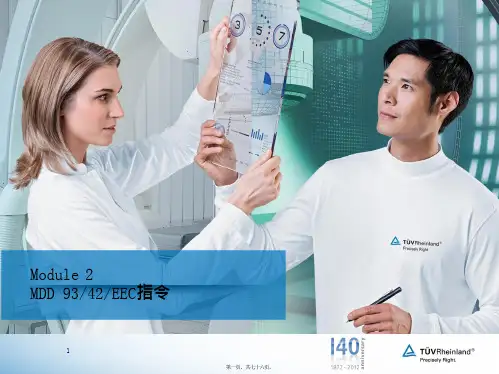
GUIDE TO GOOD MANUFACTURINGPRACTICE FOR MEDICINAL PRODUCTS药品GMP检查指南.PIC/S July 2004Reproduction prohibited for commercial purposes.Reproduction for internal use is authorised,provided that the source is acknowledged.Editor: PIC/S SecretariatP.O. Box 5695CH-1211 Geneva 11e-mail: daniel.brunner@web site: :// 1 July 2004 PE 009-2TABLE OF CONTENT目录INTRODUCTION介绍 (1)CHAPTER 1 QUALITY MANAGEMENT 质量管理 (4)PRINCIPLE 原则 (4)QUALITY ASSURANCE 质量保证 (4)GOOD MANUFACTURING PRACTICE FOR MEDICINAL PRODUCTS (GMP) 药品GMP (6)QUALITY CONTROL 质量控制 (7)CHAPTER 2 PERSONNEL 人员 (10)PRINCIPLE 原则 (10)GENERAL 通则 (10)KEY PERSONNEL 关键人员 (10)TRAINING 培训 (13)PERSONAL HYGIENE 个人卫生 (14)CHAPTER 3 PREMISES AND EQUIPMENT 厂房和设备 (16)PRINCIPLE 原则 (16)PREMISES General总则 (16)Production Area 生产区域 (17)Storage Areas 储存区域 (19)Quality Control Areas 质量控制区域 (20)Ancillary Areas 辅助区域 (20)EQUIPMENT 设备 (21)CHAPTER 4 DOCUMENTATION 文件 (23)PRINCIPLE 原则 (23)GENERAL 总则 (23)DOCUMENTS REQUIRED 必需的文件 (25)MANUFACTURING FORMULA AND PROCESSING INSTRUCTIONS 生产方法和加工指示 (27)PACKAGING INSTRUCTIONS 包装指示 (28)BA TCH PROCESSING RECORDS 批加工记录 (29)BA TCH PACKAGING RECORDS 批包装记录 (30)PROCEDURES AND RECORDS 程序和记录 (32)CHAPTER 5 PRODUCTION 生产 (36)PRINCIPLE 原则 (36)GENERAL 通则 (36)PREVENTION OF CROSS-CONTAMINATION IN PRODUCTION 生产过程中防止交叉污染 (38)V ALIDATION 验证 (39)STARTING MA TERIALS 起始物料 (40)PROCESSING OPERA TIONS - INTERMEDIATE AND BULK PRODUCTS 加工操作:中间体和散装产品 (42)PACKAGING MATERIALS 包装材料 (42)PACKAGING OPERATIONS 包装操作 (43)FINISHED PRODUCTS 最终成品 (45)REJECTED, RECOVERED AND RETURNED MATERIALS 拒绝的,回收的和退回的物料46CHAPTER 6 QUALITY CONTROL 质量控制 (48)PRINCIPLE 原则 (48)GENERAL 通则 (48)GOOD QUALITY CONTROL LABORATORY PRACTICE 优良质量控制实验室实践 (49)DOCUMENTATION 文件 (49)SAMPLING 取样 (50)TESTING 检测 (52)CHAPTER 7 CONTRACT MANUFACTURE AND ANAL YSIS 合同加工和分析 (55)PRINCIPLE 原则 (55)GENERAL 通则 (55)THE CONTRACT GIVER 合同提供人 (55)THE CONTRACT ACCEPTOR 合同接受人 (56)THE CONTRACT 合同 (57)CHAPTER 8 COMPLAINTS AND PRODUCT RECALL 抱怨和产品召回 (59)PRINCIPLE 原则 (59)COMPLAINTS 抱怨 (59)RECALLS 召回 (60)CHAPTER 9 SELF INSPECTION 自检 (61)PRINCIPLE 原则 (61)ANNEX 1 MANUFACTURE OF STERILE MEDICINAL PRODUCTS无菌药品的生产 (63)PRINCIPLE (63)GENERAL (63)BLOW/FILL/SEAL TECHNOLOGY (67)TERMINALL Y STERILISED PRODUCTS (67)ASEPTIC PREPARA TION (68)PERSONNEL (68)PREMISES (70)EQUIPMENT (71)SANITATION (71)PROCESSING (71)STERILISATION (73)STERILISATION BY HEA T (74)MOIST HEAT (75)DRY HEAT (75)STERILISATION BY RADIATION (75)STERILISATION WITH ETHYLENE OXIDE (76)FILTRATION OF MEDICINAL PRODUCTS WHICH CANNOT BE STERILISED IN THEIR FINAL CONTAINER (77)FINISHING OF STERILE PRODUCTS (77)QUALITY CONTROL (78)ANNEX 2 MANUFACTURE OF BIOLOGICAL MEDICINAL PRODUCTS FOR HUMAN USE人用生物药品的生产 (79)SCOPE (79)PRINCIPLE (79)PERSONNEL (80)PREMISES AND EQUIPMENT (81)ANIMAL QUARTERS AND CARE (82)DOCUMENTATION (82)PRODUCTION (83)QUALITY CONTROL (84)ANNEX 3 MANUFACTURE OF RADIOPHARMACEUTICALS 放射性药品的生产 (85)PRINCIPLE (85)PERSONNEL (85)PREMISES AND EQUIPMENT (85)PRODUCTION (86)QUALITY CONTROL (86)DISTRIBUTION AND RECALLS (86)ANNEX 4 MANUFACTURE OF VETERINARY MEDICINAL PRODUCTS OTHER THAN IMMUNOLOGICALS MANUFACTURE OF PREMIXES FOR MEDICATED FEEDING STUFFS 除为预混合加药饲料原料生产的免疫产品以外的,兽药产品的生产 (87)THE MANUFACTURE OF ECTOPARASITICIDES (88)THE MANUFACTURE OF VETERINARY MEDICINAL PRODUCTS CONTAINING PENICILLINS (88)RETENTION OF SAMPLES (point 1.4. viii and point 6.14.) (88)STERILE VETERINARY MEDICINAL PRODUCTS (88)ANNEX 5 MANUFACTURE OF IMMUNOLOGICAL VETERINARY MEDICAL PRODUCTS免疫兽药产品的生产 (89)PRINCIPLE (89)PERSONNEL (89)PREMISES (90)EQUIPMENT (93)ANIMALS AND ANIMAL HOUSES (94)DISINFECTION - WASTE DISPOSAL (94)PRODUCTION (95)STARTING MA TERIALS (95)QUALITY CONTROL (98)ANNEX 6 MANUFACTURE OF MEDICINAL GASES药用气体的生产 (99)1. PRINCIPLE (99)2. PERSONNEL (99)3. PREMISES AND EQUIPMENT (99)4. DOCUMENTA TION (100)5. PRODUCTION (101)6. QUALITY CONTROL (104)7. STORAGE AND RELEASE (105)ANNEX 7 MANUFACTURE OF HERBAL MEDICINAL PRODUCTS草药产品的生产 (108)PRINCIPLE (108)PREMISES (108)DOCUMENTATION (108)SAMPLING (109)QUALITY CONTROL (110)ANNEX 8 SAMPLING OF STARTING AND PACKAGING MA TERIALS起始物料和包装材料的取样 (111)PRINCIPLE (111)PERSONNEL (111)STARTING MA TERIALS (111)PACKAGING MATERIAL (112)ANNEX 9 MANUFACTURE OF LIQUIDS, CREAMS AND OINTMENTS流体,霜体和膏体药品的生产 (113)PRINCIPLE (113)PRODUCTION (113)ANNEX 10 MANUFACTURE OF PRESSURISED METERED DOSE AEROSOL PREPARATIONS FOR INHALATION吸入式剂量仪的气雾剂的生产 (115)PRINCIPLE (115)GENERAL (115)PREMISES AND EQUIPMENT (115)PRODUCTION AND QUALITY CONTROL (116)ANNEX 11 COMPUTERISED SYSTEMS 计算机化系统 (117)PRINCIPLE (117)PERSONNEL (117)V ALIDATION (117)ANNEX 12 USE OF IONISING RADIATION IN THE MANUFACTURE OF MEDICINAL PRODUCTS使用离子放射生产药品 (120)INTRODUCTION (120)RESPONSIBILITIES (120)DOSIMETRY (121)V ALIDATION OF THE PROCESS (121)COMMISSIONING OF THE PLANT (122)PREMISES (124)PROCESSING (124)DOCUMENTATION (126)MICROBIOLOGICAL MONITORING (126)ANNEX 13 MANUFACTURE OF INVESTIGA TIONAL MEDICINAL PRODUCTS观察期药品的生产 (127)PRINCIPLE (127)GLOSSARY (128)QUALITY MANAGEMENT (130)PERSONNEL (130)PREMISES AND EQUIPMENT (130)DOCUMENT A TION (131)PRODUCTION (132)QUALITY CONTROL (136)RELEASE OF BATCHES (137)SHIPPING (139)COMPLAINTS (139)RECALLS AND RETURNS (139)DESTRUCTION (140)ANNEX 14 MANUFACTURE OF PRODUCTS DERIVED FROM HUMAN BLOOD OR HUMAN PLASMA生产自人类血液或人体组织分离的产品 (143)PRINCIPLE (143)GLOSSARY (144)QUALITY MANAGEMENT (144)PREMISES AND EQUIPMENT (145)BLOOD AND PLASMA COLLECTION (145)TRACEABILITY AND POST COLLECTION MEASURES (146)PRODUCTION AND QUALITY CONTROL (147)RETENTION OF SAMPLES (148)DISPOSAL OF REJECTED BLOOD, PLASMA OR INTERMEDIATES (148)ANNEX 15 QUALIFICATION AND V ALIDATION 确认和验证 (149)PRINCIPLE (149)PLANNING FOR V ALIDATION (149)DOCUMENTATION (150)QUALIFICATION (150)PROCESS V ALIDATION (151)CLEANING VALIDATION (153)CHANGE CONTROL (154)REV ALIDATION (154)GLOSSARY (154)[ANNEX 16] [QUALIFIED PERSON AND BA TCH RELEASE]*经授权的人员和批放行 (157)ANNEX 17 PARAMETRIC RELEASE参数放行 (158)1. PRINCIPLE (158)2. PARAMETRIC RELEASE (158)3. PARAMETRIC RELEASE FOR STERILE PRODUCTS (158)4. GLOSSARY (160)[ANNEX 18] [GMP GUIDE FOR ACTIVE PHARMACEUTICAL INGREDIENTS] 17原料药GMP 指南 (161)GLOSSARY术语表 (162)GUIDE TO GOOD MANUFACTURING PRACTICE FOR MEDICINAL PRODUCTS药品GMP指南INTRODUCTION介绍为进一步消除药品贸易壁垒,促进许可证的一致性,以及确保整个欧洲在研发,生产和控制药品中保持高标准的质量保证,根据药品检查协会(PIC)同意,药品检查使用一致的GMP原则,和药品检查合作计划表中的欧洲药品GMP及其附录。
MDR法规对企业的影响2023.02.09MDR 法规发布的背景MDR 法规对质量管理体系的要求 1. 2.受影响的质量管理体系文件如何升级3.个人简介1MDR法规发布的背景一、MDR法规发布发布2017年05月05日欧盟发布了医疗器械法规,(EU)2017/745替代新的法规是基于93/42/EEC和90/385/EEC指令要求进行了升级,并替代了以往的指令二、MDR法规的发布与实施2020年4月24日,《欧洲议会官方公报》发布(EU) 2020/561法规,对医疗器械法规(MDR) [REGULATION (EU) 2017/ 745] 进行了修订,将MDR的执行日期从2020年5月26日推迟到2021年5月26日,并对其他规定的执行日期也做了相应调整。
2MDR 对质量体系的要求为什么要建立质量管理体系☐为了满足法规的要求;☐为了保证产品质量;☐为了提升充分信任;☐为了规范企业管理;☐为了改善企业业绩。
MDR对质量体系的要求医疗器械新法规的结构:有10章123条第一章范围和定义第二章上市和使用投入,经营者的义务,再加工,CE标识,自由流通第三章产品标识和追溯性,产品注册,经营者注册,产品安全和临床性能总结,欧洲数据库第四章公告机构第五章分类和合格评定第六章临床评价和试验第七章上市后监管、警戒和市场监管第八章成员国之间的合作,医疗器械协调组,专业实验室、专家组和器械登记第九章保密、数据保护、资金来源及惩罚第十章最终条款MDR对质量体系的要求MDR对质量体系的要求制造商的义务(Article 10):10.1当将其器械投放市场或投入使用时,制造商应确保所有器械均按本法规的要求进行设计和生产。
10.2 制造商应如附录 I 第 3 节所述,确立、记录、实施和维护风险管理体系。
10.3 制造商应按照载于第 61 条和附录 XIV 规定的要求进行临床评价,包括'PMCF'。
10.4 除了定制器械外器械的制造商应拟定并更新这些器械的技术文件。
附件3 制造商向国家主管当局提交报告格式表ANNEX 3 REPORT FORM FOR MANUFACTURER’S TO THE NATIONAL COMPETENT
AUTHORITY
Manufacturer’s Incident Report
制造商事故报告
医疗器械警戒系统
本人保证就本人所掌握的知识范围,上述信息是正确的。
I affirm that the information given above is correct to the best of my knowledge.
签名Signature
姓名Name:城市City:日期Date:
Submission of this report does not, in itself, represent a conclusion by the manufacturer and/or authorized representative or the National Competent Authority that the content of this report is complete or accurate, that the medical device(S) caused or contributed to the alleged death or deterioration the state of the health of any person.
本报告的提交本身并不代表制造商和/或其授权代表或国家主管当局对本报告的内容完整或准确的结论,也不代表所列医疗器械的任何错误和/或医疗器械引起或促成了宣称的任何人的死亡或其健康六况的严重损坏。
附录4 欧洲市场安全纠正措施ANNEX 4 EUROPEAN FIELD SAFETY CORRECTIVE ACTION REPORT FORM
医疗器械警戒系统(MEDDEV 2.12/1 rev 5)
本人保证就本人所掌握的知识范围,上述信息是正确的。
I affirm that the information given above is correct to the best of my knowledge.
签名Signature
姓名Name:城市City:日期Date
Submission of this report does not, in itself, represent a conclusion by the manufacturer and/or authorized representative or the National Competent Authority that the content of this report is complete or accurate, that the medical device(S) caused or contributed to the alleged death or deterioration the state of the health of any person.
本报告的提交本身并不代表制造商和/或其授权代表或国家主管当局对本报告的内容完整或准确的结论,也不代表所列医疗器械的任何错误和/或医疗器械引起或促成了宣称的任何人的死亡或其健康六况的严重损坏。